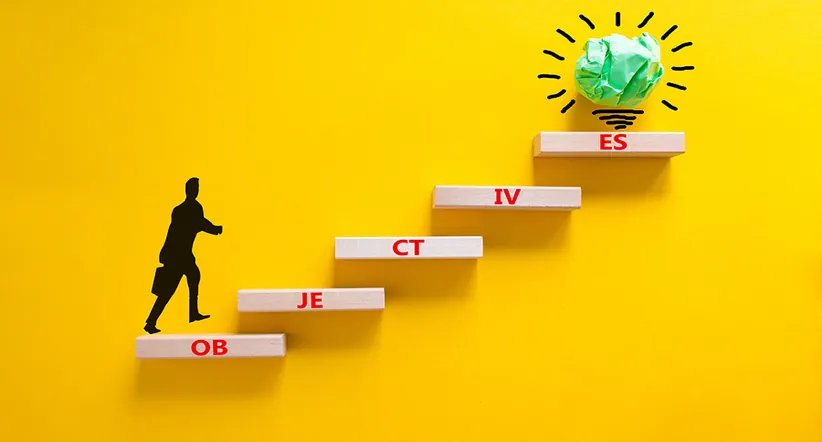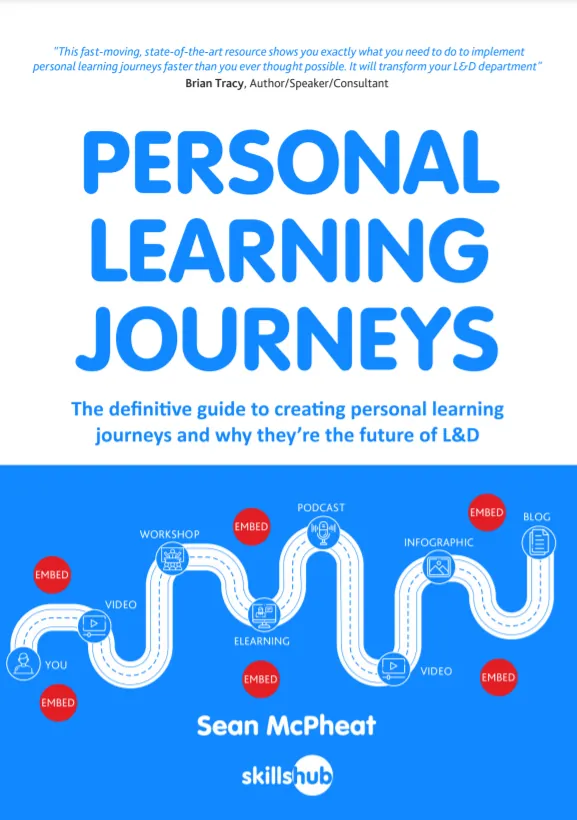
Learning objectives are a critical aspect of lessons and course planning. For teachers, they enable clear expectations of what will be covered and ensure the learning can be easily measured.
For students, learning objectives provide an overview of the key points and main building blocks covered in a topic.
Skillshub’s experience in the academic and corporate world shows that having established learning objectives can help to improve engagement, motivation, and results.
As a thought leader in the field of educational objectives, we believe there are several types and structures of learning objectives you should consider when planning a course or lesson.
In this article, we’ll look at how to write learning objectives effectively, different types of learning objectives, and provide some example objectives to help you get started.

What are Learning Objectives?
Before we cover the details of writing learning objectives, it’s important to understand what they are and why having them is essential.
Learning objectives provide an overview of the topics covered in a course or lesson and allow everyone involved—teachers, students, and even administrators—to have a shared understanding of the goals for any given session.
In simple terms, learning objectives:
- Outline what students should be able to do after completing the lesson
- Provide a shared understanding of the topics covered in a course or lesson
- Help teachers plan and assess learning activities
- Allow administrators to monitor student progress
- Make it easier for students to review key material
Essentially, learning objectives provide a framework that benefits everyone involved in the learning process.

Learn How To Create Personal Learning Journeys For FREE!
What’s the Difference Between a Learning Objective and a Learning Outcome?
Learning outcomes and learning objectives are superficially similar, as in both cases, the two terms are used to describe what students should be able to do after completing a course or lesson.
However, there is an essential distinction between the two.
A learning objective refers specifically to the topics that will be covered during a lesson/course. Learning outcomes, on the other hand, look beyond mere knowledge and provide evaluations on how well students can apply what they’ve learned.
For instance, a learning objective may be to “understand the components of the water cycle”. A learning outcome related to this might be to “identify ways in which humans are impacting the global water cycle.”
The learning objective here defines how the lesson or course should be structured, while the learning outcome provides an evaluation of how well students understand and can apply what they have learned.

Benefits of Well-Written Learning Objectives
Now that you’ve got a clearer understanding of what learning objectives are and how they differ from learning outcomes, let’s take a look at the benefits of having well-crafted learning objectives in place.
There is a wide range of material benefits associated with creating and leveraging learning objectives, including:
Improved lesson and course planning
A clearly stated learning objective provides the basis for lesson and course planning.
Well-written objectives help teachers identify not only the topics that need to be covered, but also the resources (e.g., books or videos) needed to cover them effectively.
Improved assessment
Having established learning objectives in place helps teachers create assessments which accurately evaluate student understanding of any given topic.
Teachers can use learning objectives to create quizzes, tests, and other assessments to accurately evaluate student knowledge.
Improved student understanding
Clear learning objectives are helpful for students in a number of ways.
For instance, having an overview of the topics covered in a lesson or course can help students track their progress more effectively and identify areas which may need review.
Furthermore, having objectives in place can help reduce the cognitive load associated with learning new topics, allowing students to focus more on their understanding of a subject rather than worrying about what needs to be done next.
Increased student engagement
Having established learning objectives in place can help keep students and employees engaged during lessons and lectures.
When students have a clear understanding of the topics covered, it becomes easier for them to follow along with the lesson plan and stay focused on the topic at hand.
Furthermore, providing objectives can motivate students by setting out specific goals they should be working towards.
More effective communication between teachers, students, and administrators
A shared understanding of learning objectives helps to ensure effective communication between all stakeholders in the educational process.
Teachers can use objectives to effectively communicate expectations with students, while administrators can use them to monitor student progress.
Having established learning objectives also makes it easier for teachers and administrators to identify potential issues or areas in which students may need additional support.
A better focus on the topics covered in a given course or lesson
Finally, having learning objectives in place helps to ensure that all stakeholders are focusing on the topics covered in a lesson or course.
Objectives set out specific goals which everyone should be working towards and help to keep discussions focused.
By providing an overview of the topics covered, learning objectives can also help teachers identify areas which need further exploration or review.
Overall, having clear learning objectives can help to improve results by providing everyone involved with a shared understanding of the goals of any given lesson or course.

How to Write Effective Learning Objectives
While the basic idea of learning objectives is simple, the act of creating effective learning objectives requires a bit more thought and consideration.
Let’s take a look at some tips to help you craft practical learning objectives:
Understanding the ABCD Model
The ABCD model provides a foundation for creating effective learning objectives.
The ABCD stands for:
Audience
The Audience portion of the ABCD model refers to whom the objective is intended for. The intended audience for any learning objective should modify the content and language used in the objective.
For instance, objectives for younger students may need to be simplified or contain more visual aids, whereas objectives for adult learners can assume a higher level of knowledge and use more sophisticated language.
Behaviour
The Behaviour associated with the ABCD model refers to what type of action should be taken by the audience in question.
This could include analytical thinking, problem-solving, writing, or any other behaviour which is relevant to the topic being covered.
The type of behaviour should be specific and clearly defined in order for it to be effectively measured.
Condition
The Condition portion of the model refers to what context or circumstances will have an impact on how the objective is achieved.
For instance, a learning objective may require students to solve a problem in a particular way (e.g., without using a calculator).
The condition portion of the ABCD model ensures that any necessary qualifications are taken into account when crafting an objective.
Degree
The Degree portion of the ABCD model refers to how successful students should be in order to achieve the learning objective.
This can include anything from basic understanding to complete mastery of the topic in question.
The degree should be clearly specified so that it can be effectively measured when assessing student performance.
Putting it all together
In other words, learning objectives should provide a description of who is being taught, what they should be able to do afterwards, the conditions under which this can be achieved, and how well it must be done.
Using the ABCD model provides an accessible framework that specific learning objectives can be crafted around.

Breaking Down the Process
To help you master the process of creating effective learning objectives, we’ve broken down the process into four steps:
Identify your audience
When crafting learning objectives, it’s important to consider who the objective is intended for. Identifying the intended audience will inform the language and content used in crafting the objective.
Specify desired learner behaviour
Having a specific behaviour in mind will help you create a practical learning objective. Consider which behaviours are necessary for learners to master the topic, and strive to ensure that the objectives reflect these behaviours.
Determine the conditions and constraints
The conditions and constraints surrounding the learning objective should be made explicit. This includes any qualifications or stipulations which must be met in order for learners to achieve the objective.
It should also consider any possible constraints or limitations that may impact how the objective is achieved. These constraints could include time or resource limitations, for example.
Define the degree of success desired
Finally, you should determine how successful learners must be in order to achieve the objective. This could include understanding basic concepts or mastering all aspects of a topic.
By defining the degree of success desired, it will be easier to measure whether learners have achieved the objective.
The degree should be specific and measurable in order for learners to effectively work towards it. This could include anything from basic understanding to complete mastery of the topic in question.
Taking a step-by-step process
By taking a step-by-step approach to creating practical learning objectives, it will be easier to ensure that the desired outcome is achieved.
Ideally, any learning objective should contain all of the necessary information to help learners understand what they need to do in order to succeed.
To achieve this, you should start by outlining what the learner needs to do in a clear and concise manner.
Then, break down each step into more detailed tasks to ensure that all necessary aspects of the objective are included. This could include defining any qualifications or constraints which may impact the completion of the task.
Finally, consider how successful learners must be in order to achieve the task set out in the learning objectives. This should be measurable so that learners can effectively work towards it and track their progress.
By taking a step-by-step approach to writing learning objectives, you will be able to ensure that the desired outcomes are achieved for each lesson or course.

Types of Learning Objectives
There are three primary types of learning objectives that can be used as the basis for crafting your own practical learning objectives.
Using these archetypes along with the ABCD model will help to ensure that your objectives are specific, measurable, and achievable.
Knowledge-based Objectives
Knowledge-based objectives are used to measure the learner’s understanding of a particular concept.
This type of objective should focus on testing the learner’s knowledge and comprehension in order to assess their level of understanding.
A good example of a knowledge-based objective would be:
“The learner will be able to explain the process of photosynthesis in at least three sentences.”
Skill-based Objectives
Skill-based objectives are used to assess the learner’s ability to apply their understanding of a concept.
This type of objective should focus on testing the learner’s ability to use the knowledge they have acquired in order to complete a task.
A good example of a skill-based objective would be:
“The learner will be able to apply the principles of photosynthesis to solve a problem.”
Attitude-based Objectives
Attitude-based objectives are used to assess the learner’s attitude towards the concept.
This type of objective should focus on testing the learner’s ability to think critically about a concept and their willingness to apply this knowledge in real-world situations.
A good example of an attitude-based objective would be:
“The learner will be able to demonstrate an understanding of photosynthesis and its implications for sustainability.”

Learning Objectives Examples
To help make the process of crafting practical learning objectives easier, here are some examples you can use as a reference point.
Knowledge-Based Objectives Examples
“The learner will be able to list the three main components of photosynthesis and explain their role in the process.”
“The learner will be able to identify the five primary sources of energy used in photosynthesis and explain how they are utilised.”
Skill-Based Objectives Examples
“The learner will be able to apply their knowledge of photosynthesis to construct a model demonstrating the process.”
“The learner will be able to use the principles of photosynthesis to design an experiment that tests one of its aspects. “
Attitude-Based Objectives Examples
“The learner will be able to discuss the implications of photosynthesis on climate change and how it can help reduce negative impacts.”
“The learner will demonstrate an understanding of the importance of photosynthesis for our environment and its impact on sustainability.”
Best Practices for Writing Learning Objectives
While writing learning objectives can be challenging, the good news is that there is established best practice for crafting effective and practical learning objectives.
By following these guidelines, you will be able to ensure that your learning objectives are clear, achievable, and useful.
Make your Objectives Specific and Measurable
Good learning objectives are specific and should clearly indicate what the learner needs to accomplish to achieve the desired outcome. They should also be measurable so that it is evident when the learner has achieved them.
Use Action Verbs
Action verbs should be used in the learning objectives to indicate what the learner will do. This will make it clear to both the trainer and the learners what is expected of them.
Action verbs include:
• Understand
• Identify
• Demonstrate
• Apply
Consider the Level of Difficulty
Before writing the learning objective, you should consider the difficulty level appropriate for the learners. The degree of difficulty should be challenging but also achievable so that learners can successfully work towards it.
Align objectives with the overall learning goals
Learning objectives should be aligned with the overall learning goals of the course or lesson. This will ensure that all objectives contribute towards achieving the desired outcome for the learners.

Turning Learning Objectives into Training Objectives
While learning objectives are most commonly used in educational settings to help guide the learning process, they can also be used as a basis for creating training objectives.
Training objectives should focus on the desired outcomes from the training activity and use similar language and structure as learning objectives.
The critical difference is that the focus will be more on how to best achieve these outcomes rather than what needs to be learned.
Some strategies for turning objectives into training objectives include:
- Focus on how to effectively apply the knowledge or skills acquired from the learning activity.
- Consider how best to facilitate the transfer of this knowledge or skill so that learners can use it in their professional lives.
Make sure the objective is measurable and achievable.
An example of a training objective derived from a learning objective is:
Learning Objective: “The learner will be able to identify the five primary sources of energy used in photosynthesis and explain how they are utilised.”
Training Objective: “The learners will understand how to combine different sources of energy to create new products or applications.”
Developing content and assessments that align with objectives
The primary difference between learning and training objectives is that learning objectives focus on knowledge acquisition, whereas training objectives focus on skill development.
Where learning objectives prioritise content that teaches the learner about a specific concept, training objectives focus on developing problem-solving skills that can be applied to real-world scenarios.
When it comes to assessments, learning objectives should align with content and assessments that allow learners to demonstrate their understanding of the material. This could include multiple choice questions, short answer tests, and even practical activities.
By comparison, assessments for training objectives should encourage learners to apply their skills in a practical setting. This could include case studies, simulations, and group activities that allow learners to use the knowledge they have acquired in a problem-solving context.
Assessing and Evaluating Learning Objectives
Once written, learning objectives should not be static and should be reviewed regularly to ensure they are still relevant and achievable. To assess the learning objectives, it is essential to use both formative and summative assessments.
Formative assessments should be used during the learning process to measure progress and help identify any areas where learners may need additional support or guidance. This could include quizzes, tests, or group activities.
On the other hand, summative assessments should be used at the end of the learning process to measure the transfer of learning. These could include essays or presentations that require learners to demonstrate their understanding of the material.
By regularly assessing and evaluating your learning objectives, you can ensure they remain relevant and achievable for all learners. This is particularly true of training objectives where the application of the skills acquired is tested in a practical setting.

Measuring Learning Objectives
The ability to measure learning objectives is essential for assessing the success of a course or lesson. Learning objectives should be measurable to ensure it is evident when learners have met them.
As mentioned, formative assessments should be used during the learning process to help measure progress, while summative assessments should be used to measure how much learners have learned.
Other methods for measuring learning objectives include:
- Pre- and Post-Tests: This involves administering a test or quiz before and after the lesson to measure how much the learners have learned.
- Self-Assessments: Ask learners to reflect on what they have learned at the end of each lesson or session.
- Observation: An observer can be used to watch a learning activity and provide feedback on how well learners are performing.
- Projects: Ask learners to create a project or product at the end of the lesson that demonstrates their understanding of the material.
By using these different methods of measurement, you can ensure that your learning objectives are being met and that learners are gaining the knowledge and skills they need to succeed.
Final Thoughts
Learning objectives are essential for any educational or training setting.
By measuring learning objectives regularly, you can more accurately track the success of your course or lesson and ensure that all learners achieve their desired outcomes.
Skillshub’s innovative eLearning platform makes it easy for trainers to create, measure, and assess learning objectives. With tools like quizzes and assessments, and reporting tools to track progress, Skillshub can help you ensure that all learners are achieving their desired outcomes.
Our professionally designed off-the-shelf courses are also a great way to get started and provide you with all the tools and resources you need to develop engaging and interactive courses.
With our comprehensive suite of e-learning solutions, Skillshub can ensure that your learners have the knowledge and skills they need to succeed.
If you’re looking for an easy and efficient way to create, measure, and assess learning objectives, Skillshub is the perfect platform for you.
As an eLearning company, Skillshub is committed to creating efficient and impactful learning experiences.
Contact us today to find out how we can help you achieve your educational goals.













